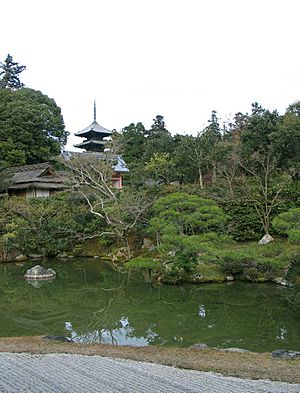Ninna facts for kids
Ninna (仁和) was a Japanese era name (年号,, nengō,, lit. "year name") after Gangyō and before Kanpyō. This period started in February 885 and ended in April 889. The reigning emperors were Kōkō-tennō (光孝天皇) and Uda-tennō (宇多天皇).
Events of the Ninna era
- 17 September 887 (Ninna 3, 26th day of the 8th month): Emperor Kōkō died at the age of 57. Kōkō's third son received the succession (senso). Shortly thereafter, Emperor Uda formally acceded to the throne (sokui). This was confirmed in ceremonies.
- 12 May 887 (Ninna 3, 17th day of the 11th month): Mototsune asks Uda for permission to retire from his duties; but the emperor persuades him to continue to serve as kampaku.
- 887 (Ninna 4, 8th month): Construction of the Buddhist temple complex at Ninna-ji (仁和寺) was completed; and a former disciple of Kōbō-daishi was named to be the leader of the monks who lived there.
Related pages
- National Diet Library, "The Japanese Calendar" -- historical overview plus illustrative images from library's collection
| Ninna | 1st | 2nd | 3rd | 4th |
|---|---|---|---|---|
| 885 | 886 | 888 | 889 |
| Preceded by: Gangyō |
Era or nengō: Ninna |
Succeeded by: Kanpyō |
Images for kids

All content from Kiddle encyclopedia articles (including the article images and facts) can be freely used under Attribution-ShareAlike license, unless stated otherwise. Cite this article:
Ninna Facts for Kids. Kiddle Encyclopedia.


